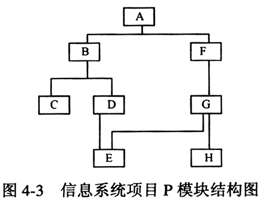阅读以下技术说明,根据要求回答问题1~问题4。
[说明]
系统集成商Y公司承担了某企业的信息系统项目P的开发建设工作,Y公司任命柳工为项目经理。该信息系统项目P包括A~H 8个应用子系统,其结构如图4-3所示,其中子系统D与G的业务运行依赖于公共模块E。

现计划采用自顶向下的方法执行信息系统P的测试项目,该项目包括多个作业。设作业A的任务是对模块A进行测试,作业B的任务是对模块B进行测试……依此类推。作业P的任务是对项目P进行整体测试。表4-14列出了该项目各作业计划所需的天数、至少必需的天数(即再增大花费也不能缩短的天数),以及每缩短1天测试所需增加的费用。图4-4是尚未完成的该项目计划图,其中,每条箭线表示一个测试作业,箭线上标注的字母表示作业名,数字表示计划测试天数。
表4-14 项目P测试计划表
|
| 假设该信息系统测试项目已按原计划部署,到了第7天末,发现模块A与模块B已按计划测试完成,但模块F却刚测试完,比原计划延迟了2天。为了保证该项目仍能在原计划总天数内完成,则至少应增加多少费用应缩短哪些作业多少天 |
参考答案:
解析:将作业G缩短1天,需要增加2500元 这是一道要求读者掌握虚作业对压缩工期及其所发生费用影响的综合分析题。本题的解答思路如下。 (1) 该测试项目已按原计划部署,到了第7天末,发现模块A与模块B已按计划测试完成,但模块 F却刚测试完,比原计划延迟了2天。此时,路径“
 →①→③→④→⑥→⑦”所花费的测试时间至少需要21天,该路径成为了该测试项目新的关键路径。由此可见,要保证该项目能在原计划总天数(20天)内完成,就需要将某作业的测试时间缩短1天。 (2) 只有缩短处于新关键路径上的作业的完成时间,才可能保证该项目仍能在原计划总天数内完成,且缩短作业测试天数时所增加的费用最少。路径“→①→③→④→⑥→⑦”所涉及的作业有A、F、G、 H、P。其中,作业A、F已完成测试任务,是测试天数不可再发生变化的作业。由问题3的分析过程可知,作业P不允许缩短其测试时问。 (3) 若将作业G的测试时间缩短1天,则所需增加的费用为2500元。此时,作业G这一测试任务将在项目开始的第11天完成,而作业D这一测试任务也将在项目开始的第11天完成,因此作业E可以按计划的时间进度进行。因此能满足图4-8中“④”与“⑤”之间的虚作业对作业D、G、E的衔接关系。 (4) 若将作业H的测试时间缩短1天,则所需增加的费用为2000元。此时,完成作业G测试任务是在项目开始的第12天,虽然作业D是在项目开始的第11天完成测试任务的,但作业E的最早开始时间只能等到第13天。这一变化将使路径“→①→②→⑤→⑥→⑦”所花费的时间变为21天,成为了该测试项目新的关键路径,而完成该测试项目计划仍需要21天。如果要使该项目能在原计划总天数(20天)内完成,则还需要将作业E的测试时间缩短1天,所需增加的总费用为4000元(>2500元)。 显然,同时将作业H、E缩短1天测试时间的方案所需增加的总费用大于只将作业G缩短1天的方案,因此通过压缩工期来弥补前期工作的延迟,所增加费用较小的方案是将作业G的测试时间缩短1天。
→①→③→④→⑥→⑦”所花费的测试时间至少需要21天,该路径成为了该测试项目新的关键路径。由此可见,要保证该项目能在原计划总天数(20天)内完成,就需要将某作业的测试时间缩短1天。 (2) 只有缩短处于新关键路径上的作业的完成时间,才可能保证该项目仍能在原计划总天数内完成,且缩短作业测试天数时所增加的费用最少。路径“→①→③→④→⑥→⑦”所涉及的作业有A、F、G、 H、P。其中,作业A、F已完成测试任务,是测试天数不可再发生变化的作业。由问题3的分析过程可知,作业P不允许缩短其测试时问。 (3) 若将作业G的测试时间缩短1天,则所需增加的费用为2500元。此时,作业G这一测试任务将在项目开始的第11天完成,而作业D这一测试任务也将在项目开始的第11天完成,因此作业E可以按计划的时间进度进行。因此能满足图4-8中“④”与“⑤”之间的虚作业对作业D、G、E的衔接关系。 (4) 若将作业H的测试时间缩短1天,则所需增加的费用为2000元。此时,完成作业G测试任务是在项目开始的第12天,虽然作业D是在项目开始的第11天完成测试任务的,但作业E的最早开始时间只能等到第13天。这一变化将使路径“→①→②→⑤→⑥→⑦”所花费的时间变为21天,成为了该测试项目新的关键路径,而完成该测试项目计划仍需要21天。如果要使该项目能在原计划总天数(20天)内完成,则还需要将作业E的测试时间缩短1天,所需增加的总费用为4000元(>2500元)。 显然,同时将作业H、E缩短1天测试时间的方案所需增加的总费用大于只将作业G缩短1天的方案,因此通过压缩工期来弥补前期工作的延迟,所增加费用较小的方案是将作业G的测试时间缩短1天。

